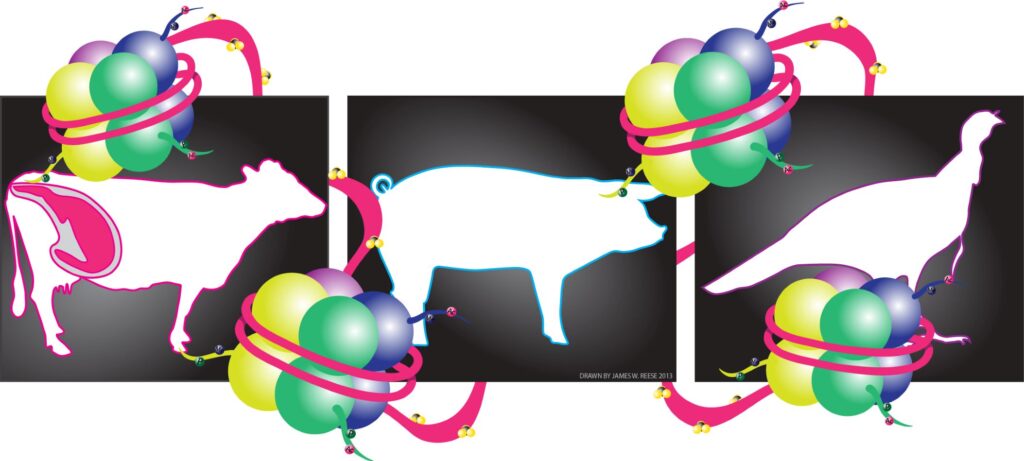Summary of Research Interests
Assisted reproduction in humans and animals has been linked to inappropriate control of the epigenome in gametes and preimplantation embryos that results in adverse consequences during fetal and postnatal development. Commonly used assisted reproductive technology (ART) procedures include: ovarian hyperstimulation (superovulation), in vitro maturation, in vitro fertilization, intra-cytoplasmic sperm injection, embryo culture, and embryo transfer. The research conducted in my laboratory aims at understanding the mechanisms whereby manipulations of mammalian gametes and embryos result in alterations of the epigenome. The long term goal of our research is to provide recommendations in order to decrease the negative side effects associated with ART. The laboratory is currently engaged in several research projects. The main projects are summarized below.

Follow this link to watch a short presentation given as part of the South Farm Research Center virtual field day.
Follow this link for a Blog from a mother of a child born with BWS (link used with permission).
EN ESPANOL – Sjga este enlace para ver una presentacion que resume las actividades del laboratorio de la Dra. Rivera.
A. Characterization of a loss-of-imprinting overgrowth syndrome associated with the use of assisted reproduction in humans and bovids.
a. Beckwith-Wiedemann syndrome (BWS) is the most common pediatric overgrowth syndrome. The most prevalent features found in BWS patients are macroglossia, macrosomia, and exomphalos, polyhydramnios and visceromegaly. These children also have an increased likelihood of tumor development, especially Wilm’s tumor of the kidney. Reports estimate a 3- to 9-fold increased likelihood of BWS in children conceived by ART. Large offspring syndrome (LOS) is a similar overgrowth condition which occurs in bovids as a result of commonly used ART procedures. There is an unmet need for an animal model to study BWS since the rodent models do not recapitulate the overgrowth phenotype or show the set of characteristics that are used to diagnose a patient with BWS. We have recently shown that LOS and BWS are phenotypically and epigenotypically similar. We have sequenced the transcriptome of brain, muscle, kidney, and liver of four control and four LOS day ~105 fetuses and are currently analyzing the reads to determine which genes and biological pathways differ in their expression between treatment groups. The next step in this project is to associate gene expression to chromatin state. With this line of research we aim to characterize the etiology of these loss-of-imprinting conditions and determine when the development of the syndrome is first triggered in utero. Additionally, we aim to elucidate how ART induces the syndromes. A long term goal of this line of research is to determine if dietary intervention (i.e. methyl donor supplementation) at specific times during the pre-, peri-conception and/or fetal development will ameliorate and/or correct the phenotype.
Large offspring syndrome (LOS) ART procedures are used in cattle to improve genetic merit of the offspring in a shorted length of time when compared to natural reproduction. In addition, ART can be used to produce experimentally- (genetically-) manipulated animals with improved production traits. As mentioned earlier ART can result in LOS in cattle which can have detrimental effects on the offspring and dam and also pose managerial and financial challenges to the producer. The long term goal of this this line of research is to develop diagnostic assays that may be used to identify embryos that are molecularly programmed to suffer the overgrowth condition prior to transfer, thus decreasing the likelihood of LOS in ART-produced offspring.
B. Effects of superovulation and ageing on the oocyte’s epigenome
a. Superovulation – Ovarian hyperstimulation by administration of exogenous gonadotropins is used in humans and animals to increase the number of ovarian follicles from which oocytes will be ovulated or mechanically retrieved. Any intrusion during the growth phase of oocytes could potentially affect the expression of genes required for oocyte maturation, fertilization, and successive embryo and fetal development. In fact, studies in mice show that superovulation increased the proportion of abnormal preimplantation embryos, increased the rate of postimplantation mortality, and caused pronounced fetal growth retardation when compared to naturally ovulated counterparts. Similarly, reports in humans suggest an increased incidence of musculoskeletal defects in children conceived after ovarian hyperstimulation. Our studies show that in mice, superovulation affects the epigenome of the oocyte prior to ovulation which results in misexpression of genes at the blastocyst stage. We have also demonstrated that DNA methylation is acquired in an oocyte size-specific manner in adult mice and that superovulation interferes with the epigenetic reprogramming that occurs during oocyte growth. This in turns translates to inappropriate retroelement control in fully-grown eggs. Finally, we have shown that superovulation results in inadequate control of gene expression in oocytes for at least three cycles subsequent the superovulation procedure. We have identified FSH as the hormone involved in this phenomenon and studies are underway to identify mechanism.
b. Ageing – In mammals, an inverse correlation exists between the fertility of females and their chronological age. The reduction in mammalian fertility with age is multifactorial and is greatly influenced by oocyte quality and quantity as well as lowered embryo development. In a previous study from our laboratory, we observed that oocytes of aged female mice had higher levels of global DNA methylation than oocytes from young females. We hypothesize that this is an FSH-induced phenomenon. We further hypothesize that the increased DNA methylation observed in aged oocytes can promote methyl DNA binding domain and Polycomb group proteins induced chromatin contraction and can in part be responsible for the low developmental competence observed in these oocytes. We are currently testing these hypotheses.

